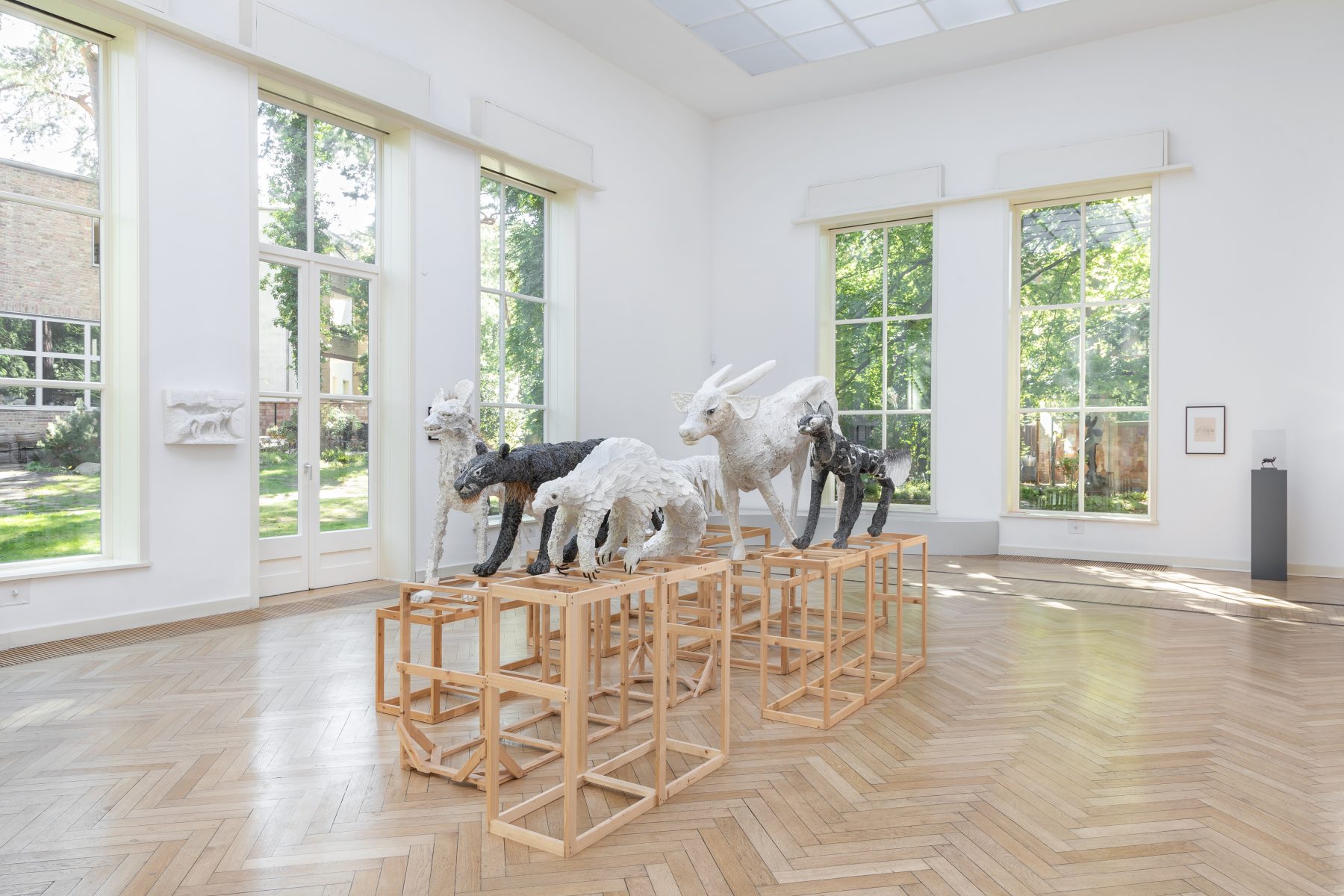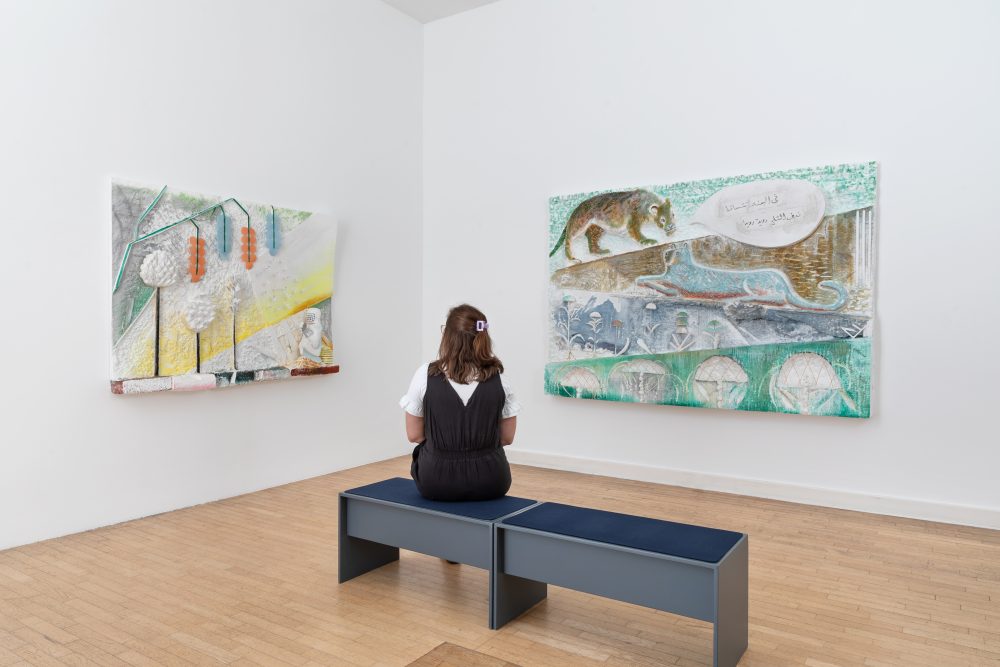
Lin May Saeed. The Snow Falls Slowly in Paradise.
A Dialogue with Renée Sintenis
14. September 2023 – 25. February 2024
To suppose that animals first entered the human imagination as meat or leather or horn is to project a 19th century attitude backwards across the millennia. Animals first entered the imagination as messengers and promise.
John Berger, Why Look at Animals?, 1980
In the works of Lin May Saeed (1973, Würzburg-2023, Berlin), the life of animals and the relationship between animals and humans are central themes. With a consistent formal language, a great deal of empathy, a broad cultural-historical knowledge of fairy tales and fables, and also with humour, the artist tells old and new stories of the subjugation and liberation of animals and their coexistence with humans. The sculptures, reliefs, metal works, expansive silhouettes and drawings of the German-Iraqi sculptor are a new visual language of solidarity and coexistence between species.
In her first solo museum exhibition in Germany, Lin May Saeed’s artistic works come together with works on loan to and collected by the Georg Kolbe Museum by Renée Sintenis (1888, Glatz-1965, West Berlin). Sintenis, a central figure of modern sculpture, was also searching for a way to explore and portray the relationship between animals and humans, when she celebrated her breakthrough in the 1920s with small-format animal sculptures. The most famous – the Berlin Bear – is still awarded annually as part of the Berlinale Film Festival. The cross-generational dialogue emerging at the Georg Kolbe Museum between these two artists traces not only formal developments in animal sculpture, but also examines the changes in society’s image of animals over the past 100 years. It also points to a new relevance in our perception and treatment of other living beings, such as the role of industrial animal husbandry in the context of the climate catastrophe. As they will have decayed, neither the bronze nor marble will bear witness to human creativity as sculptural materials in the distant future. Styrofoam, on the other hand, will forever remain intact. This is why Lin May Saeed chooses this petroleum-based, non-biodegradable plastic for her works. For her, it stands as a reminder of man’s impact on the environment. And so, Lin May Saeed’s art is constantly engaging in a political discourse in the context of the man-made age of the Anthropocene.
The exhibition shows sculptures made of Styrofoam, steel and bronze as well as silhouettes and drawings by both artists and is accompanied by a comprehensive educational and events programme on animality, animal ethics and animal rights. More Information.
The exhibition was created in close collaboration with Lin May Saeed.
About the artists:
Lin May Saeed (1973, Würzburg-2023, Berlin) was a German-Iraqi artist based in Berlin. She studied at the Kunstakademie Düsseldorf and co-founded the project space Center in Berlin. Her recent solo exhibitions were held at the Clark Institute, Williamstown, USA (2020); Studio Voltaire, London (2018) and Lulu, Mexico City (2017). Group exhibitions include Museum Frieder Burda Baden-Baden (2023); Museo Castello di Rivoli, Turin; Fondation Carmignac, Porquerolles; Museum of Contemporary Art Antwerp (all 2021); Aspen Art Museum, USA (2020); Palais de Tokyo, Paris; Ljubljana Biennale of Graphic Arts, Slovenia and Villa Merkel, Esslingen (all 2019); Schirn Kunsthalle, Frankfurt; mumok, museum moderner kunst, Vienna (all 2018) and Köln Skulptur (2017).
Renée Sintenis (1888, Glatz -1965, West Berlin) was one of the most famous and successful Berlin sculptors of the Weimar Republic. She trained at the Kunstgewerbeschule in Berlin. In 1915 she exhibited for the first time at the Berlin Secession; in the 1920s she was an omnipresence in art and society and, like Georg Kolbe, was represented by the gallery owner Alfred Flechtheim. In 1931 she was one of the first women to be appointed to the Prussian Academy of Arts; in 1934 she was forced to resign by the National Socialists, who harboured doubts about her Aryan origins. After the war, she was appointed as one of the first female professors at the Hochschule der Künste and was readmitted to the Akademie der Künste in 1955. Sintenis was known as an animal sculptor, and her works can be found in public spaces in Berlin as well as in important museum collections worldwide. One of her designs was the Berlin Bear, a larger version of which greets travellers to Berlin as they approach from the south, north and west.
For the Artists on Artists format, the artist collective Slavs and Tatars (founded 2006, Berlin) created an audio guide of their favorite Lin May Saeed works for the exhibition on Bloomberg Connects.



